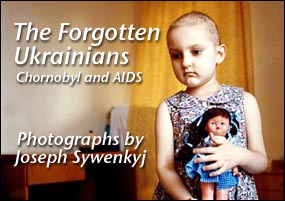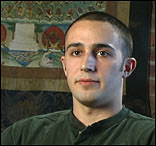|
Introduction
by Helen Buttfield
When you know what
a photographer chooses to look at, you have already learned a great
deal about him. "Those little rectangles," as Roy Stryker
so perceptively referred to photographs, tell us the rest. Joseph Sywenkyj,
who is still a very young man, has already chosen to enter a world that
most of us choose to avoid: the field of human suffering. His first
essay, in black and white, was a meditation on the suppressed, hidden
lives of two autistic brothers, whom he photographed with tenderness
and great intelligence, using his lens to penetrate their silence.
Now he has taken on the darker, more dreadful silence caused by our
ignorance of the suffering that has resulted from the explosion at Chornobyl
in 1986. He has done this by returning to the country of his fathers,
where both the language and his long familiarity with Ukrainian traditions
have been his allies. His photographs from the hospitals and orphanages
he visited oblige us to see, as if we were standing there ourselves,
the cruel deformations that radiation has imposed on children's bodies
and to feel the pain they cause. How can we bear to look at them? Because
his photographs also contain a terrible beauty that sustains us as we
take in their truth. Perhaps it is the painted blue wall that appears
behind one boy, his spine so curled backward that he seems to be rising
from a sea of infinite blue.
In another we see a field of cots with four boys, each in his cot, each
body twisted, each wrapped in his own pain. We see the first one, then
a second, and a third and finally a fourth, younger, still able to sit.
And we experience them one at a time, directly, each an individual bound
in his own world. In a third, easier to bear, the linked figures of
two attendants create a living circle that encloses a tiny infant as
if to protect him, lying prone and helpless in the radiant light. The
nurse in white, as graceful as a Botticelli goddess, seems in her beauty
to be a figure that absorbs and even transcends suffering.
Ukraine is also enduring one of the worst HIV/AIDS epidemics in Europe,
where the region's stumbling economy and dysfunctional health system
make it impossible for most of the sufferers to afford the medication
which could ease their pain and keep them alive. Sywenkyj, working with
Doctors Without Borders and other humanitarian organizations, has responded
to this crisis with equal passion, using his camera to reveal not only
the sufferings of the victims but the courage of others working to change
their despair into hope.
Photographers like Joseph, who can look steadily at the unbearable,
have a tremendous power, the power to capture images that convert ignorance
into awareness and fear into understanding, without which there can
be no change. Fortunately for the world, in the hands of such strong
and compassionate photographers these images are, as Roy Stryker said
so long ago, "one of the damnedest educational tools ever made."
Enter
Joseph Sywenkyj's Photo Gallery
|

